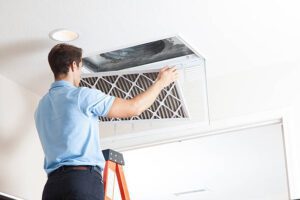Because water heaters come in various brands and models, their best performance is usually determined by where they are installed. However, vertical placement of a water heater is preferred.
Table of Contents
ToggleWater heaters can be installed horizontally or vertically. This is because many people want to save space at home while also making their decor look more upscale. Will laying down a heater affect or improve its performance? Let us investigate.
How Does A Water Heater Work?
Before determining whether turning a water heater on its side will improve its performance, we must first understand how it works. The operation of a water heater is simple.
First and foremost, the water heater operates through a process known as thermal stratification. This entails keeping the top area’s water temperature higher to be used for things like bathing. On the other hand, the water at the bottom of the tank is kept at a lower temperature.
Lowering a water heater’s temperature changes how the water flows through the tank and travels around inside the tank.
Furthermore, if it were laid, the pipe that transfers hot water around the tank would be fixed in the middle rather than the top. The free flow of water would be hampered as a result. When a water heater is turned on its side, air pockets form, limiting the volume of hot water.
Also, Read: What Temperature Should A Tankless Water Heater Be Set At
How Do You Transport A Laid-Down Heater?
Even though transferring a water heater horizontally is easier than vertically, you must proceed cautiously to avoid breaking anything.
The following are the steps for relocating a water heater sideways.
1. Find A Flat Spot.
The first step is to find an appropriate placement for your water heater. Keep anything that could harm the water heater away from it. It is straightforward for some to try to put the water heater into the back of a large car or SUV.
If you fold down the seats in the back of the truck or automobile, you might be able to keep the water heater from moving.
2. Secure The Water Heater.
As one might assume, when a water heater is turned on its side, it rolls. It is impossible to roll the water heater since it will damage the inside of the water heater. Ratchet Straps should be used to fasten the water heater because of this.
The straps will restrict the water heater from moving around while driving, preventing it from rolling. Some individuals use ratchet straps to connect the heater to the dolly directly. This procedure can help remove the water heater from the vehicle.
-
Padding.
Use padding to keep your water heater safe. Using a moving blanket is the easiest technique to ensure that nothing breaks. However, make certain that the blankets or comforters are thick enough to keep anyone safe from harm. Thin blankets have a higher chance of scratching or damaging the water heater.
It might make sense for plumbers who frequently install water heaters to incorporate a box into their vehicle to accommodate a standard-sized water heater. If you have a lot of work to do during the week, this is a better option than constantly strapping down the water heater. Plumbers will tell you that unloading a water heater horizontally is completely safe, but you must ensure that it does not roll and that nothing is placed on top of it when you move it.
Can I Pay To Move My Water Heater?
If you’ve read our tips on how to move a water heater and decided you can’t do it, you’ll almost certainly need to hire someone to help you. When you hire a plumber to replace a water heater, they usually include moving it in their services.
However, this does not always happen, and you may need to move the water heater yourself. Moving a water heater and purchasing a new one on your own is less expensive than hiring a plumber.
If the thought of doing this overwhelms you and you’re concerned about what might go wrong, hiring someone is a good idea. Having someone pick up and move your water heater is usually only a couple hundred dollars. This will set you back at least $500. Hiring a local plumber for a job like this would be wise.
Conclusion.
You should now be able to make an informed decision about transporting your water heater. If you are working on this project by yourself, we recommend that you seek assistance from a friend or relative.
A large and bulky water heater takes up a lot of room. If you do this on your own, you will almost certainly cause irreversible damage and may also injure yourself.
Also, the question “Can you lay a water heater on its side?” is surrounded by myths and old wives’ tales. The answer is Yes, but you should try to avoid doing it if at all possible. It’s hazardous because the pieces inside could shift, or the sides could stretch and shatter the glass inside. That is the correct explanation. At your own risk, transport the water heater on its side.
FAQ.
Is it possible to turn an electric water heater on its side?
Electric and gas water heaters should be installed in the orientation for which they were designed. Installing a vertical electric water heater horizontally will reduce efficiency, reliability, and safety.
Should I switch off the water heater while on vacation?
If you’re going on a long trip, dialing down the temperature of your water heater can help you save money on electricity. Turn it down as needed, as this may cause the water heater to malfunction or take longer to heat up when you get home.
Is it possible to install a hot water heater horizontally?
A vertical water heater should not be placed horizontally. The hot water line will no longer be at the tank’s top but in the center. This makes it harder for hot water to rise easily.





















